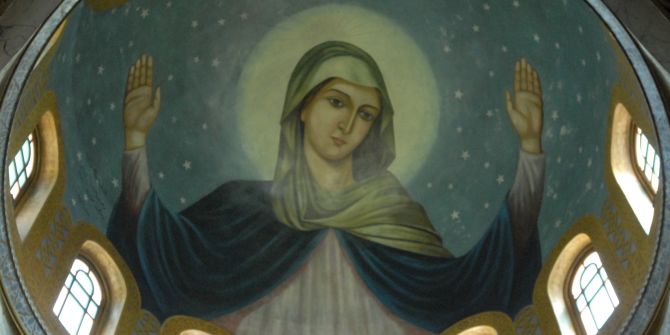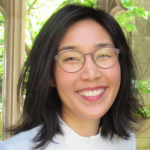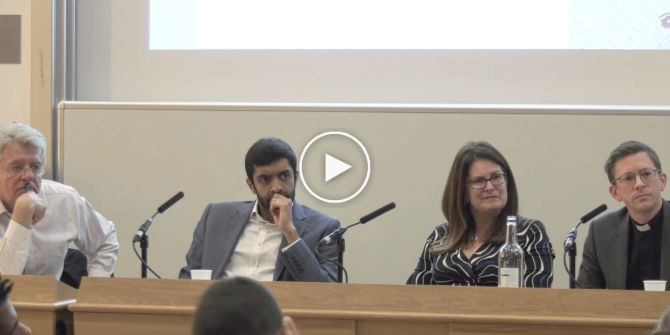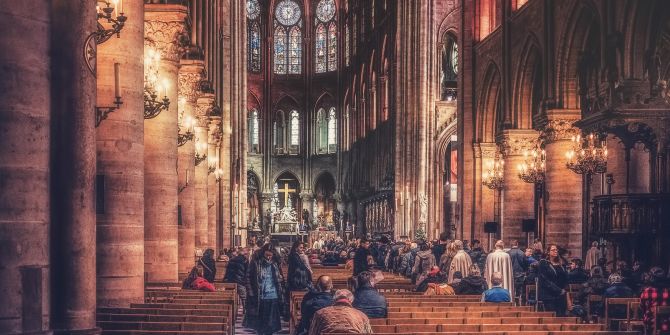In a collaboration with the University of Helsinki, we interviewed Angie Heo about her forthcoming book ‘The Political Lives of Saints: Christian-Muslim Mediation in Egypt’. Angie discusses the public role that saints play in mediating interfaith relations in Egypt, and the inherently political nature of religious iconography in a volatile, complicated country. She also shares her insights on recent Egyptian history, and what initially drew her to the region.

Congratulations on your forthcoming book The Political Lives of Saints: Christian-Muslim Mediation in Egypt. Let’s open with discussing your book’s title and subtitle. What do they mean?
I find saints at once fascinating and useful for many reasons. My title is a nod to the hagiographic genre of venerating holy persons, or the Lives of the Saints. For an anthropologist, saints are a great topic for describing and analyzing the extraordinary qualities of the anthropos. What could be more wild and wonderful than monks flying around in the air like little black jets and martyrs magically growing back their limbs after they’ve been thoroughly scalded and sawed off? Saints have also inspired an enormous body of scholarship on how different nations and religions intersected and overlapped with one another, not only in Mediterranean Europe and North Africa but also in South and Southeast Asia all the way to Russia. This is why, I think, the study of popular saints (and by my liberal use of “saint” here, I include holy figures such as awliya, pirs, lamas, etc…) has often led to theoretical engagement with religious difference by way of concepts such as syncretism, hybridity and ecumenism.
My subtitle “Christian-Muslim Mediation in Egypt” captures my main argument and method. I argue for examining saints as vehicles of mediating social relations between Christians and Muslims in Egypt across various registers of political belonging – communal, national, global, sectarian and minoritarian. In my book, I resist romanticizing saintly cults into depoliticized sites of transcending or doing away with religious differences. If anything, I show that the Coptic Church and Egyptian state rely quite a bit on saints to organize and manage distinctions between Copts and Muslims under the rubric of nationhood. My study analyzes the very practical work that imagining saints does toward creating and contending with core institutions of authoritarian rule in contexts of war, revolution and coup. Hence, my title “The Political Lives of Saints.”
What are some important points you hope that readers will take away from your book?
A strong case can be made that Eastern Orthodox traditions, compared to other Christianities such as Protestantism or Catholicism, have received significantly less attention in scholarship. Coptic Orthodoxy, in particular, is a minority tradition not only within the Arab Muslim world, but also relative to Eastern and Western Christendom. Given its Alexandrian origins in St. Mark, Coptic Orthodoxy is also regarded as an indigenous tradition with native roots in Greco-Roman antiquity and Egyptian soil. Copts signify Europe’s civilizational origins, as they are imagined as the “early Christians.” At the same time, the Orthodox have shared landscapes of shrines and saint veneration with Jews and Muslims over centuries, and only in recent centuries have confronted Catholic and Protestant missionization. All these characteristics of Coptic Orthodoxy suggest that it is an ideal tradition through which to study the politics of Arab versus Western identity, and contemporary expressions of antiquity.
My book is 100% about Coptic Orthodoxy and Copts, but in my mind, its main contribution is not merely a study of Coptic Orthodoxy and Copts. What I really seek to propose is a method of studying Christian-Muslim relations. There is already a lot of important work that studies Christian-Muslim relations in two directions. The first pursues something along the lines of inter-faith dialogue, drawing out comparative elements in Christianity and Islam based on literary and historical sources. The second explores the sectarian dimensions of state rule, often focusing on how law secures religious identity and difference. In my book, I draw on these two directions, but I do so by venturing into the realm of saint veneration to consider how religion in everyday life underwrites communal and national politics in Egypt.
Throughout the process of writing each chapter, I continually asked myself the question: what are the terms of common belonging that shape relations between Christians and Muslims in Egypt? I approach saints as media of Christian-Muslim relations; they are what shape the terms of common belonging. Here, by going to the ritual and technological dimensions of religious mediation, I build on the burgeoning literature on religion and media. Saints are not so much authentic expressions of a religious identity as they are the material and practical means of ordering the space and time of belonging. We can also learn a lot about the sectarian designs of the Egyptian nation-state through the Coptic Church’s widely cultivated identification with saints like the Virgin and the late Pope Kyrillos. It is through the saintly imagination that the Copts inhabit their ties with Muslims and establish their location in the nation at large.
What initially drew you to do your fieldwork in Egypt? What was it like to cover Coptic Christians during the period of your research?
When I was an undergraduate, I taught English to refugees from Somalia and Bosnia in Boston with other teachers who were of Kashmiri and Sudanese descent. Like many other Korean-Americans, my background is Protestant Christian, and more specifically, Reformed Calvinist. I was impressed by the piety of my Muslim colleagues and students, and I wanted to learn more about Islam and travel to a country where Christians were a minority. So I went to Egypt as a music teacher for an international school in Cairo straight after graduation. I had this idea that Christians in Muslim-majority countries were more likely to have a more tolerant and ecumenical outlook on other faiths and religious groups. Not only did I quickly find out how completely wrong this idea of mine was, I also found that Coptic Orthodoxy, with its enormous pantheon of saints and visual images, was so far from everything I knew about Christianity at that point in my life.
After enrolling in a doctoral program, I first began my formal spell of fieldwork in 2004, and I filed my dissertation in 2008. If you read my book, however, you will notice that most of my materials are gathered between 2010 and 2015. Along with everyone else, I had no inkling that anything like the Arab uprisings were coming up. Beginning in late 2009, there were a few attacks that brought me back to Egypt, but nothing near the level of violence that Copts would experience in the following years. After the Tahrir protests that led to Mubarak’s downfall in 2011, the situation of Copts and of all Egyptians was rapidly changing and felt unpredictable. I decided that I would continue fieldwork through the instability and tumult in many of the sites I already knew well, and so I returned to Egypt every year until 2015. The result is a work that addresses questions that I had not even asked before 2008 – questions about religion’s relationship to militarization, violence and security for example. I am now very glad that I took the risk of writing a book that turned out so thoroughly different from my thesis, although I certainly had my moments of doubt as to whether or not it was worth it!
Your approach to studying saints engages interdisciplinary work on media, art and material culture. Why did you take this approach?
Orthodox Christianity is full of visual images, so it would take significant effort to overlook questions about art and material culture. My book is divided into three parts: relics, apparitions and icons. I make the case that these three categories of saintly representation are genres of social imagination (rather than discrete art-objects). My book also includes 40 illustrations which I added to help readers get a better grasp of the range and variety of holy images that I cover.
On empirical and theoretical levels, there is a lot to be gained by going the media and materiality route to analyze the public and political value of saints. Scholarship on Copts usually takes an actor-centered approach, privileging the discourse and rhetoric of leading figures in the Coptic community. How do you get to the ordinary Copts who aren’t giving speeches or interviewing with the newspapers? I found that documenting how people interact with saints – i.e. the social and material life of images – is one way to do that. We can see how images organize senses of how holy land is living and what a holy person looks like. And then, we can have a better handle on the communicative aspects of widely political forms such as sacred territory and cult publicity, for example.
Ultimately, studying saintly representations also opens up my analysis so that I can consider how Coptic Orthodoxy serves as a key domain of governing Christian-Muslim relations. Copts and Muslims practice their religious lives in largely separate and segregated spheres; this is part of the reason why the stereotype of the Coptic community is that it is insulated, isolated, even secretive. A material analysis of saints and their social aesthetics can help us track precisely what is at stake in upholding the Virgin as a national sign of interfaith unity in one context, and as a communal sign of sectarianism in another. Images are media of communication, and holy images shape the religious terms through which Copts forge their common belonging with Muslims in Egypt and other Christians elsewhere. We can learn a lot by paying attention to what is being mediated, how and under what conditions.
What are some of the most common misconceptions about Copts and Christian-Muslim relations in the Middle East? How does your book address them?
Probably the most prevalent misconception is that Copts are being exterminated and that Coptic Christianity is on the path to extinction. Before the coup in 2013, the Muslim Brotherhood and Salafist groups at the helm of the presidency and parliament were causes of widespread anxiety. After the coup, the rise of ISIS throughout the Middle East amounted to gruesome attacks on Copts. For sure, Copts are facing serious levels of discrimination and violence. But the fact remains that the systemic forms of exclusion, vulnerability and repression that Copts confront on a regular basis are owed to authoritarian structures of state rule rather than anti-Christian ideological sentiment. Aside from this fact, the idea of Christians in the Middle East facing extermination mobilizes currents of Islamophobia in North America and Europe, and quite disturbingly, continues on unaccountable in public life.
The Egyptian state’s ally is the Coptic Church, and the contents of Coptic Orthodoxy itself are thoroughly implicated in modern transformations tied to state authority. In my bolder moments, I would even go so far as to claim that the Egyptian state relies on the Coptic Orthodox imagination as a key domain of its governance. So you see, Coptic Christianity is actually being activated, not going extinct. My book provides longer term perspective into Egyptian state authoritarianism and the legacies of postcolonial nation-building after the 1952 coup. The Coptic Church and the Coptic community developed much of its religious identity and centralized tactics of rule under Gamal Abdel Nasser. When we study church-sanctioned imaginaries of martyr commemoration, for example, we can see how religious rituals are conscripted into shoring up communal authority, and at times, military power. As my book shows, they don’t always succeed, and their failure is also very instructive. Incidents of violence happen, but what happens before and after these incidents demands thoughtful examination.
Who do you envision your book’s audience to be?
My main audience is readers who are interested in religion. This includes people who are curious about similarities between Christianity and Islam, and the diversity of traditions within Christianity. Copts are a small group, but by virtue of their unique history, they have borrowed from and interacted with so many different Christianities: Roman Catholicism, Greek and Russian Orthodox, Evangelical Protestantism. Aside from Christianity and Islam per se, Copts also offer an intriguing window into classical antiquity. During my research, I had never expected to be reading up on dream incubation and the medicinal cult of Asklepion, or on magical practices of divination. The ancient world turned out to be a really interesting locus for exploring both Christian and Islamic sensibilities in the present.
I also hope my book reaches readers interested in religion and media, as well as religion and nationhood in postcolonial contexts. My approach is deeply ensconced in so much of the work on mediation, embodiment and technology that has flourished in recent decades. Egypt has also produced so much influential scholarship across disciplines, particularly in history and anthropology. In anthropology alone, the work on Islam and on secularism has had an enormous impact on the ways that I think about tradition and sectarianism. If that comes through and if my book ends up finding company in the literature which had inspired it, I would be absolutely thrilled.
Note: For an audio version of this interview, head to the University of Helsinki’s Anthropology blog
About the author
 Angie Heo is Assistant Professor of the Anthropology and Sociology of Religion at the University of Chicago. Her first book is The Political Lives of Saints: Christian-Muslim Mediation in Egypt (University of California Press, 2018).
Angie Heo is Assistant Professor of the Anthropology and Sociology of Religion at the University of Chicago. Her first book is The Political Lives of Saints: Christian-Muslim Mediation in Egypt (University of California Press, 2018).
Note: This piece gives the views of the author, and not the position of the LSE Religion and Global Society blog, nor of the London School of Economics.





